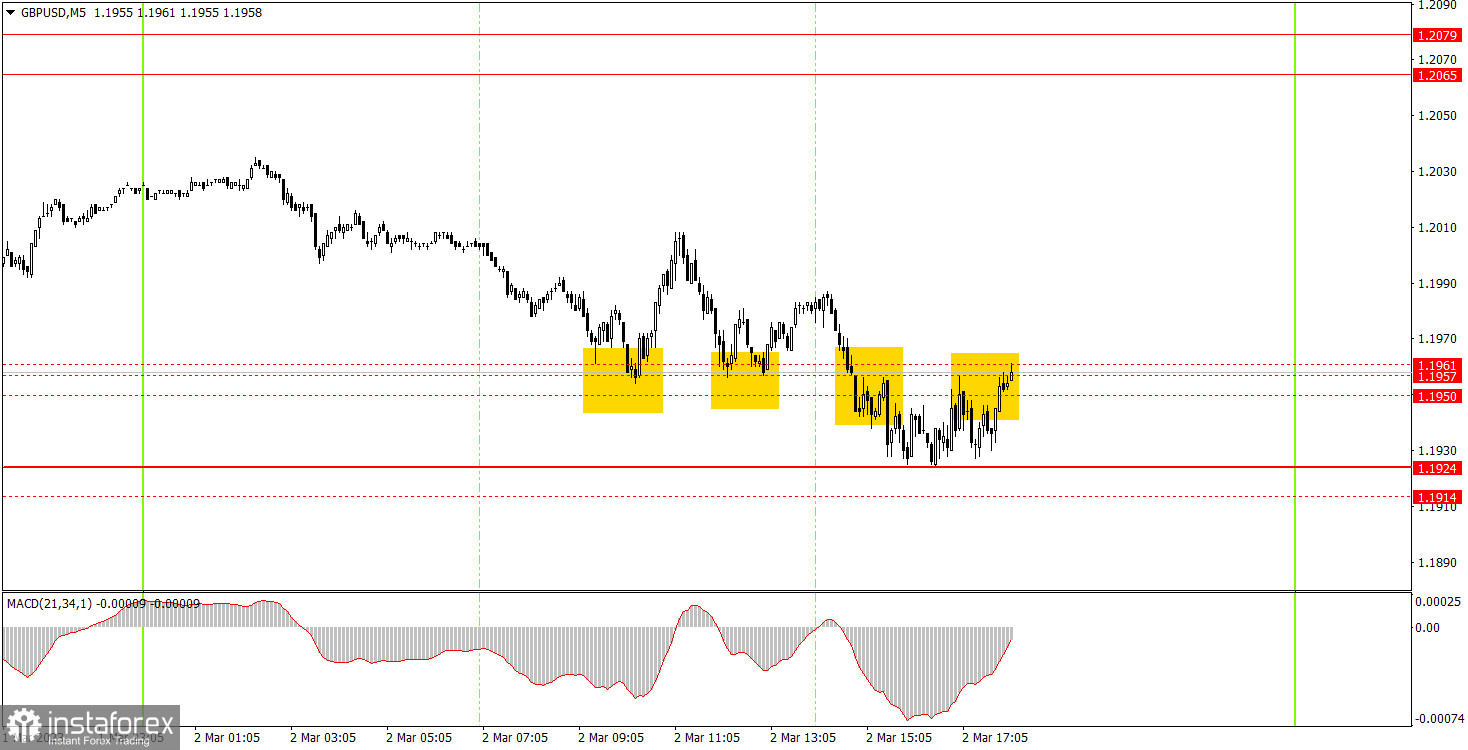Analyzing Thursday's trades:
GBP/USD on 30M chart

GBP/USD fell back to 1.1924. We changed several levels under the pair's current movements, so pay attention to this moment. On the 30-minute chart, we can see that the price is in a horizontal channel between 1.1924 and 1.2143, and that is not the only channel. If we look at the 24-hour chart, we can notice a flat, which has been going on for three months and is about 500 pips wide. Thus, we have two flats at once and more "swings". There were hardly any important events or reports in the UK and the US. The jobless claims report does not count. The British pound started to fall in the evening, so it was obviously not influenced by the fundamental or macroeconomic background. Thus, we have a picture, when the horizontal channel is of paramount importance. Until the pair does not get out of it, there is no sense to expect the market to react to any fundamentals and macroeconomics, as well as to the trend movement.
GBP/USD on 5M chart

Despite the fact that the pair was moving down all day and showed volatility of 110 points, it still wasn't a favorable situation. There were frequent reversals and pullbacks, which made it difficult to trade. All the signals were formed in the area of 1.1950-1.1961, which was removed from the charts by the end of the day. All four signals turned out to be false. Unfortunately, this often happens in a flat. Beginners could work out only the first two signals - the bounces from the specified area. In the first case, the price went up 36 points, in the second by 10 points. A Stop Loss was triggered at breakeven on the first trade, and a loss was made on the second trade when the next sell signal was formed. The last two signals should not be triggered. A rebound from 1.1924 may cause the pair to sharply rise on Friday, because it is the lower limit of the horizontal channel. Breaking through this level may provoke a strong drop in quotes.
Trading tips on Friday:
On the 30-minute chart, GBP/USD started a new spiral of the upward movement, but quickly ended it. At the moment, there is no clear trend, trend line or channel for the pair. We consider that it may be flat on the higher chart, while there will be the frequent changes of direction on the lower chart, i.e. "swings". The key level at the moment is 1.1924. On the 5-minute chart, it is recommended to trade at the levels 1.1716, 1.1793, 1.1863-1.1877, 1.1924, 1.2065-1.2079, 1.2138, 1.2171-1.2179, 1.2245-1.2260. As soon as the price passes 20 pips in the right direction, you should set a Stop Loss to breakeven. On Friday, the UK and the US are set to publish PMIs in the service sectors. Fed representatives will also deliver speeches, but all of them will take place later in the evening.
Basic rules of the trading system:
1) The strength of the signal is determined by the time it took the signal to form (a rebound or a breakout of the level). The quicker it is formed, the stronger the signal is.
2) If two or more positions were opened near a certain level based on a false signal (which did not trigger a Take Profit or test the nearest target level), then all subsequent signals at this level should be ignored.
3) When trading flat, a pair can form multiple false signals or not form them at all. In any case, it is better to stop trading at the first sign of a flat movement.
4) Trades should be opened in the period between the start of the European session and the middle of the US trading hours when all positions must be closed manually.
5) You can trade using signals from the MACD indicator on the 30-minute time frame only amid strong volatility and a clear trend that should be confirmed by a trendline or a trend channel.
6) If two levels are located too close to each other (from 5 to 15 pips), they should be considered support and resistance levels.
On the chart:
Support and Resistance levels are the levels that serve as targets when buying or selling the pair. You can place Take Profit near these levels.
Red lines are channels or trend lines that display the current trend and show in which direction it is better to trade now.
The MACD indicator (14, 22, and 3) consists of a histogram and a signal line. When they cross, this is a signal to enter the market. It is recommended to use this indicator in combination with trend patterns (channels and trendlines).
Important announcements and economic reports that can be found on the economic calendar can seriously influence the trajectory of a currency pair. Therefore, at the time of their release, we recommend trading as carefully as possible or exiting the market in order to avoid sharp price fluctuations.
Beginners on Forex should remember that not every single trade has to be profitable. The development of a clear strategy and money management is the key to success in trading over a long period of time.
 English
English 
 Русский
Русский Bahasa Indonesia
Bahasa Indonesia Bahasa Malay
Bahasa Malay ไทย
ไทย Español
Español Deutsch
Deutsch Български
Български Français
Français Tiếng Việt
Tiếng Việt 中文
中文 বাংলা
বাংলা हिन्दी
हिन्दी Čeština
Čeština Українська
Українська Română
Română

